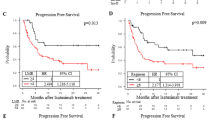Abstract
The aim of this study was to evaluate a prognostic score for aids-related lymphoma (ARL). A retrospective study of 104 patients with ARL treated between January 1999 and December 2007 was conducted. Diffuse large B-cell lymphoma (DLBC) was the most observed histological type (79.8%). The median CD4 lymphocyte count at lymphoma diagnosis was 125 cells per microliter. Treatment response could be evaluated in 83 (79.8%) patients, and 38 (45.8%) reached complete remission (CR); overall response rate was 51.8% (95 CI = 38.5–65.1%). After a median follow-up of 48 months, the 4-year overall survival (OS) rate among all patients was 35.8%, with a median survival time of 9.7 months (95% CI = 5.5–13.9 months). The survival risk factors observed in multivariate analysis (previous AIDS and high-intermediate/high international prognostic index (IPI)) were combined to construct a risk score, which divided the whole patient population in three distinct groups as low, intermediate, and high risk. When this score was applied to DLBC patients, a clear distinction in response rates and in OS could be demonstrated. Median disease-free survival (DFS) for patients that achieved CR was not reached, and DFS in 4 years was 83.0%. Our results show that the reduced OS observed could be explained by poor immune status with advanced stage of disease seen in our population of HIV-positive patients. Further studies will be needed to clarify the role of different treatment approaches for ARL in the setting of marked immunosuppression and to identify a group of patients to whom intensive therapy could be performed with a curative intent.



Similar content being viewed by others
References
Kaplan LD, Straus DJ, Testa MA et al (1997) Low-dose compared with standard-dose m-BACOD chemotherapy for non-Hodgkin's lymphoma associated with human immunodeficiency virus infection. National Institute of Allergy and Infectious Diseases AIDS Clinical Trials Group. N Engl J Med 336:1641–1648
Gisselbrecht C, Oksenhendler E, Tirelli U et al (1993) Human immunodeficiency virus-related lymphoma treatment with intensive combination chemotherapy. French–Italian Cooperative Group. Am J Med 95:188–196
Levine AM, Sullivan-Halley J, Pike MC et al (1991) Human immunodeficiency virus-related lymphoma. Prognostic factors predictive of survival. Cancer 68:2466–2472
Lim ST, Karim R, Nathwani BN et al (2005) AIDS-related Burkitt's lymphoma versus diffuse large-cell lymphoma in the pre-highly active antiretroviral therapy (HAART) and HAART eras: significant differences in survival with standard chemotherapy. J Clin Oncol 23:4430–4438
Navarro JT, Ribera JM, Oriol A et al (1998) International prognostic index is the best prognostic factor for survival in patients with AIDS-related non-Hodgkin's lymphoma treated with CHOP. A multivariate study of 46 patients. Haematologica 83:508–513
Navarro JT, Ribera JM, Oriol A et al (2007) Advanced stage is the most important prognostic factor for survival in patients with systemic acquired immunodeficiency syndrome-related non-Hodgkin's lymphoma treated with CHOP and highly active antiretroviral therapy. Int J Hematol 86:337–342
Raphael M, Borish B, Jaffe ES (2001) Lymphomas associated with infection by immune deficiency virus (HIV). In: Jaffe ES et al (eds) Tumours of haematopoietic and lymphoid tissues. IARC, Lyon, pp 260–271
Hoelzer D, Ludwig WD, Thiel E et al (1996) Improved outcome in adult B-cell acute lymphoblastic leukemia. Blood 87:495–508
Magrath IT, Shad AT, Sandlund JT (1997) Lymphoproliferative disorders in immunocompromised individuals. In: Magrath Ian (ed) The non-Hodgkin's lymphomas. Arnold, London, pp 955–974
McKelvey EM, Gottlieb JA, Wilson HE et al (1976) Hydroxyldaunomycin (Adriamycin) combination chemotherapy in malignant lymphoma. Cancer 38:1484–1493
Cheson BD, Horning SJ, Coiffier B et al (1999) Report of an international workshop to standardize response criteria for non-Hodgkin's lymphomas. NCI Sponsored International Working Group. J Clin Oncol 17:1244–1253
Sandler AS, Kaplan LD (1996) Diagnosis and management of systemic non-Hodgkin's lymphoma in HIV disease. Hematol Oncol Clin North Am 10:1111–1124
Spina M, Jaeger U, Sparano JA et al (2005) Rituximab plus infusional cyclophosphamide, doxorubicin, and etoposide in HIV-associated non-Hodgkin lymphoma: pooled results from 3 phase 2 trials. Blood 105:1891–1897
Wang ES, Straus DJ, Teruya-Feldstein J et al (2003) Intensive chemotherapy with cyclophosphamide, doxorubicin, high-dose methotrexate/ifosfamide, etoposide, and high-dose cytarabine (CODOX-M/IVAC) for human immunodeficiency virus-associated Burkitt lymphoma. Cancer 98:1196–1205
Galicier L, Fieschi C, Borie R et al (2007) Intensive chemotherapy regimen (LMB86) for St Jude stage IV AIDS-related Burkitt lymphoma/leukemia: a prospective study. Blood 110:2846–2854
Oriol A, Ribera JM, Bergua J et al (2008) High-dose chemotherapy and immunotherapy in adult Burkitt lymphoma: comparison of results in human immunodeficiency virus-infected and noninfected patients. Cancer 113:117–125
Mounier N, Spina M, Gabarre J et al (2006) AIDS-related non-Hodgkin lymphoma: final analysis of 485 patients treated with risk-adapted intensive chemotherapy. Blood 107:3832–3840
Kaplan LD, Lee JY, Ambinder RF, Sparano JA et al (2005) Rituximab does not improve clinical outcome in a randomized phase 3 trial of CHOP with or without rituximab in patients with HIV-associated non-Hodgkin lymphoma: AIDS-Malignancies Consortium Trial 010. Blood 106:1538–1543
Boué F, Gabarre J, Gisselbrecht C et al (2006) Phase II trial of CHOP plus rituximab in patients with HIV-associated non-Hodgkin's lymphoma. J Clin Oncol 24:4123–4128
Miles SA, McGratten M (2005) Persistent panhypogammaglobulinemia after CHOP–rituximab for HIV-related lymphoma. J Clin Oncol 23:247–248
Krishnan A, Zaia J, Forman SJ (2003) Should HIV-positive patients with lymphoma be offered stem cell transplants? Bone Marrow Transplant 32:741–748
Wagner-Johnston ND, Ambinder RF (2008) Blood and marrow transplant for lymphoma patients with HIV/AIDS. Curr Opin Oncol 20:201–205
Author information
Authors and Affiliations
Corresponding author
Rights and permissions
About this article
Cite this article
Tanaka, P.Y., Pracchia, L.F., Bellesso, M. et al. A prognostic score for AIDS-related diffuse large B-cell lymphoma in Brazil. Ann Hematol 89, 45–51 (2010). https://doi.org/10.1007/s00277-009-0761-3
Received:
Accepted:
Published:
Issue Date:
DOI: https://doi.org/10.1007/s00277-009-0761-3




